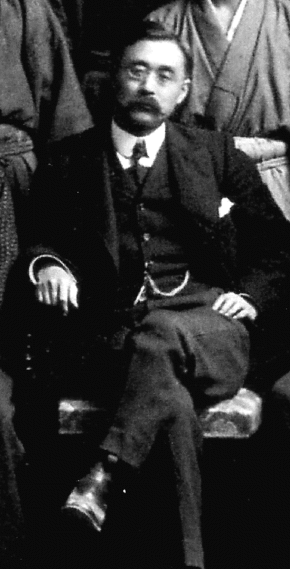Welcome to the geofictician wiki.
Angel Keum: Difference between revisions
imported>Luciano (Created page with "290px|thumb|right|A very early photograph of Sr Keum from 1859, taken shortly after the end of civil war.'''Ángel Keum''' (''Gohangukian'' Geum Do-hun [...") |
imported>Luciano m (Luciano moved page FA:Ángel Keum to Angel Keum) |
| (One intermediate revision by the same user not shown) | |
(No difference)
| |
Latest revision as of 16:44, 7 January 2019
Ángel Keum (Gohangukian Geum Do-hun [금도훈 hanja 琴度勲] - born 1803, Macondo, DC; died 1871, Villa Constitución, DF) was the 6th president of the Ardisphere, serving two full five-year terms from 1855 until 1865. The founder of the Partido Federal, he led the country during the fractious and nearly disasterous Ardispherian Civil War, and by many he is considered to have been the Ardisphere's greatest and most important president, commonly called the "Savior of the Federation" (El Salvador de la Federación).
During the divisive elections of 1855, the preceding president, Aquiles Huidobro, had originally intended to step down, as Keum battled against Octavio Sepúlveda of the Partido Liberal, who made many promises to the increasingly restive autonomists in the periphery of the country. Most historians agree that in sheer number of votes, Keum won the election, but the margin was so small and there had been so many irregularities that the election ended up in the Federal Senate. Unfortunately, the Senate failed to muster a quorum, because the autonomists had walked out en masse, with the consequence that the election was considered constitutionally undecided. Huidobro's auto-coup permitted Keum to take office, but the consequence was the secession of the Departamento del Sur under Governor Reina McQueen (later joined by the Departamento Boreal under Espartero Yun), and the beginning of the Civil War.
As president Keum navigated the complexities of the war masterfully, and despite a poor start, the war was won by 1858. Although his Federalist platform had denied all the autonomists' demands, Keum realized the wisdom of amnesty and reconciliation. Thus it was that even though the autonomists lost the war, many of their more reasonable demands were fulfilled during Keum's second administration, after reelection in 1860. Keum was so popular and successful that at the end of his second term, allies in Congress attempted to amend the constitution to allow him a third term, but he was adamant that he should step down, and so he sponsored his somewhat mediocre Prime Minister, Daniel Menores, to succeed him. Menores essentially won the election on Keum's campaign support, and Keum was fairly active "behind the scenes" in ensuring the continuity of the Menores Administration.
Unfortunately, as he passed his 65th birthday in 1868, Keum's health began failing, and he was forced to step away from his leadership role in the Partido Federal that he had founded. The former president having disappeared from the public sphere, Menores lost the 1870 election to a resurgent Partido Liberal under Oscar Robertson, and by the time Keum passed away the following year, it almost seemed that the Civil War had never occurred - politics had returned to "normal."
Nevertheless, Keum's legacy is unequaled: he gave the Ardispheric Federation its modern political form, and the party he founded has continued to be the largest or second largest party in government continuously for the last 150 years.
Early Life and Background
Keum was born to a Gohangukian merchant family that had settled in Macondo, on the west bank of the Río Albañiles about 50 km upstream from the metropolis. He was sent to the Gohangukian liceo in Caracol, DS, (that liceo no longer exists). He studied land surveying, and was unable to afford university, so at age 18 he began working for the Departmental government of Departamento del Centro as an assistant surveyor and then, quickly, chief surveryor. Many maps survive in the national archive with his customary signature Agrimensor K (Land Surveyor K). By age 23 he was leading a department working on surveying the northern part of the departamento (the region of Departamento del Centro which later was split off and became Departamento Libertad).
Political Beginnings
Keum's success in the surveying department led him to return to the capital and become increasingly involved in the departamental government. His supervisor in the land office was his future political opponent, Octavio Sepúlveda, and when Sepúlveda ran for and was elected to a congressional seat in 1831, Keum joined his boss in the capital as an assistant. Although he never studied in university, Keum proved to be a talented rhetorician and when Sepúlveda joined president Efraín García's cabinet as minister of interior, Keum became his deputy. Throughout the García administration, Keum was essentially a technocrat, but by the time García died and his Prime Minister Isabel Richard succeeded him as president, Keum was feeling alienated by the Partido Liberal's constant appeasement of the increasingly uncompromising autonomists. Thus in 1838 Keum resigned his position and ran as a member of the newly formed but short-lived Partido Unionista for a seat in the Departamento del Centro's legislature. He was one of only 5 candidates of the new party to achieve electoral victory, and by the time he entered the legislature he was viewed as a rising star.
Departmental Assembly
... more, later! ...
Governorship
... more, later! ...
1855 Election
... more, later! ...
Huidobro's Coup
... more, later! ...
Presidency and Civil War
... more, later! ...
1860 Election
... more, later! ...
Second Term
... more, later! ...
Post-Presidency
... more, later! ...
Political and Cultural Legacy
... more, later! ...
